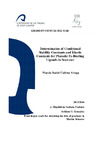Identificador persistente para citar o vincular este elemento:
https://accedacris.ulpgc.es/jspui/handle/10553/55890
| Campo DC | Valor | idioma |
|---|---|---|
| dc.contributor.advisor | Santana Casiano, Juana Magdalena | - |
| dc.contributor.advisor | González González, Aridane | - |
| dc.contributor.author | Cadena Aizaga, Marcia Isabel | - |
| dc.date.accessioned | 2019-07-02T13:38:54Z | - |
| dc.date.available | 2019-07-02T13:38:54Z | - |
| dc.date.issued | 2016 | en_US |
| dc.identifier.uri | https://accedacris.ulpgc.es/handle/10553/55890 | - |
| dc.description.abstract | Conditional stability constant and rates of formation and dissociation for the inorganic iron species (Fe′) and for Fe3+ complexation with three model polyphenols,(±) – catechin, sinapic acid and gallic acid were measured in UV-treated seawater by competitive ligand adsorptive stripping voltammetry (CLE-CSV) and kinetic approach using the iron binding ligand TAC (2-(2-thiazolylazo)-p-cresol). Conditional stability constants for the ligands ranged from log K′Fe′L 11.0 to 11.9. The stoichiometry of the complexes formed between dissolved Fe (dFe) and the polyphenols, in UV-seawater, was 3.5:1, 1.5:1 and 1:2.8 for (±) – catechin, sinapic acid and gallic acid, respectively. The formation rate constant varied from 3.82•105 to 4.16•105 M-1s-1 and dissociation rate constant 1.88•10-4– 4.4•10-4s-1. The conditional stability constant (log K′Fe′L) computed from the kinetic approach was from 8.96 to 9.4. The different dFe-binding capacity of polyphenols is highly affected by the interaction with Mg2+ and Ca2+ in seawater. Moreover, the dFe-binding ligands are able to keep Fe in solution for longer between 26 – 61 min for Fe′ species and 0.7 – 1.8 years for Fe3+. | en_US |
| dc.language | eng | en_US |
| dc.relation | Efecto de la Acidificación y Del Calentamiento Oceánico en El Comportamiento Biogeoquímico Del Fe en El Alántico Norte. | en_US |
| dc.subject | 2307 Química física | en_US |
| dc.subject.other | Biogeoquímica | en_US |
| dc.subject.other | Sewater | en_US |
| dc.subject.other | Acidificación del océano | en_US |
| dc.title | Determination of conditional stability constants and kinetic constants for phenolic Fe-Binding ligands in seawater | en_US |
| dc.type | info:eu-repo/semantics/bachelorThesis | en_US |
| dc.type | BachelorThesis | en_US |
| dc.contributor.departamento | Departamento de Química | en_US |
| dc.contributor.facultad | Facultad de Ciencias del Mar | en_US |
| dc.investigacion | Ciencias | en_US |
| dc.type2 | Trabajo final de grado | en_US |
| dc.description.observaciones | This study was involved in the project “Efecto de la Acidificación y el Calentamiento Oceánico en el comportamiento biogeoquímico del Fe en Atlántico Norte (EACFe)” and was also financed for the French program LabexMer. | en_US |
| dc.utils.revision | Sí | en_US |
| dc.identifier.matricula | TFT-37537 | es |
| dc.identifier.ulpgc | Sí | en_US |
| dc.contributor.buulpgc | BU-BAS | en_US |
| dc.contributor.titulacion | Grado en Ciencias del Mar | es |
| item.fulltext | Con texto completo | - |
| item.grantfulltext | open | - |
| crisitem.project.principalinvestigator | Santana Casiano, Juana Magdalena | - |
| crisitem.author.orcid | 0000-0002-1646-7751 | - |
| crisitem.author.fullName | Cadena Aizaga, Marcia Isabel | - |
| crisitem.advisor.dept | GIR IOCAG: Química Marina | - |
| crisitem.advisor.dept | IU de Oceanografía y Cambio Global | - |
| crisitem.advisor.dept | Departamento de Química | - |
| crisitem.advisor.dept | GIR IOCAG: Química Marina | - |
| crisitem.advisor.dept | IU de Oceanografía y Cambio Global | - |
| crisitem.advisor.dept | Departamento de Química | - |
| Colección: | Trabajo final de grado | |
Visitas
188
actualizado el 05-jul-2025
Descargas
440
actualizado el 05-jul-2025
Google ScholarTM
Verifica
Comparte
Exporta metadatos
Los elementos en ULPGC accedaCRIS están protegidos por derechos de autor con todos los derechos reservados, a menos que se indique lo contrario.
